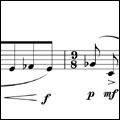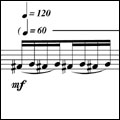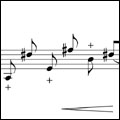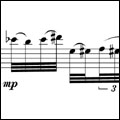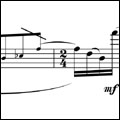Five Studies for Solo Violoncello

from the opening of Phrases.

The sonic quality of the cello is ideally suited to slow, expressive, languorous music. The instrument is also blessed with a wide compass: a rich sonorous bass register way up into the territory of the violin, and here with a powerful, unique and incisive timbre. But the music contained in these Studies in Movement favours lightness, speed and agility, and that dance-like fleet-of-footness found in the best Baroque performance practice, and notably in the dance movements of the six Cello Suites of J.S.Bach. Like the Bach suites, these studies are designed for the four and five string cello: the five studies from Set 1 are
scored for the conventional 4-string instrument; the four studies from Set 2 explore various scodatura possible with the 5-string instrument.
scored for the conventional 4-string instrument; the four studies from Set 2 explore various scodatura possible with the 5-string instrument.
All nine studies are based on a sequence of 9 consecutive patterns (S85-93) taken from Nicholas Slonimsky’s Thesaurus of Scales and Melodic Patterns. This celebrated thesaurus, beloved of jazz musicians and improvisers, was originally conceived as a resource for composers. Those who have regularly used Slonimsky’s resources include such celebrated figures as John Adams and Frank Zappa. Adams has even developed his own software module called The Earbox, which he uses to impose different colours and emotional effects on more conventional scales and patterns. Since 1995 Nigel Morgan has used his own library of Slonismky patterns as starting points for some 14 compositions in collaboration with the computer environment for music composition Symbolic Composer.

The Studies presented here are a preface to the composition Ideograms in the composer’s series Facts of Life. This is an expanding collection of music for instruments and Active Notation of which Ideograms for cello solo, designed for on-line distribution and performance, is part. Both works have been inspired by the remarkable cellist Peter Gregson, a musician who is able to bring a unique experience of Baroque techniques together with a fascination for the latest technological innovations (he has collaborated with MIT Media Lab and Banff Centre for the Arts). Click here for more information about Peter. These Studies in Movement may be performed in any order or combination. All but one (Dance Figures) make use of an extended rhythmic notation found in the string quartet Le Jardin Sec and Piece d’Orgue for organ. Note that in the above example, and throughout the work, accidentals only apply to the note which they precede.
Click on the images below to explore the individual Studies:
Downloads
Studies in Movement [pdf]
Annotated SCOM code [pdf]
Reference Recordings: I [mp3] II [mp3] III [mp3] IV [mp3] V [mp3]
Links

